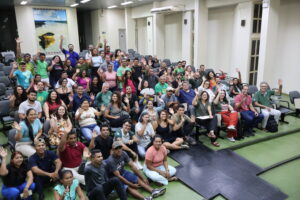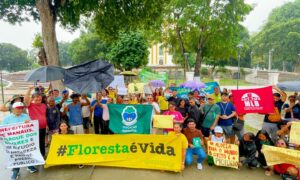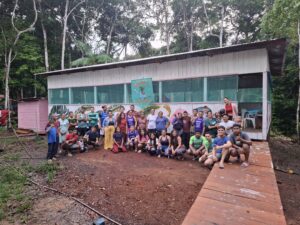The results of the Gender Diagnosis in the Mid-Juruá highlight differences concerning time use between men and women, agro-extractivist work earnings, and the consequences of teenage pregnancy.
By Camila Duarte Ritter, Nathalia Messina and Clara Machado
The women from the Mid-Juruá gathered at an association meeting to define as a priority the need for diagnostic research aiming at assessing the historical gender inequalities in the region. To better understand how women are affected by the structural sexism that has historically persisted and continues to take place in the rural reality, the Association of Agroextractivist Women of Mid-Juruá (ASMAMJ) asked for support to carry out the research intitled Diagnóstico de Gênero e Juventude nas Cadeias de Valor do Médio Juruá.
In May 2022, a team of researchers conducted interviews with more than 300 adults in different communities from the Mid-Juruá with the help of six young people from the community. The questions of this interview were elaborated based on a series of meetings with leaders and local residents to meet real demands that are to be assessed. Furthermore, talks in focal groups were carried out to understand the participation of each gender in the value chains that are consolidated in the region: rubber, arapaima, oil seeds, oak berry, fishing, and manioca.

After collecting the data and carrying out the analyses, the diagnosis was presented this year to the women of the territory during the General Assembly of the ASMAMJ, held in the Community of Roque between the 6th and 8th of March.
A result that draws attention in the research relates to the distribution of “productive” and “reproductive” working time between men and women. Women dedicate 34% of their time to domestic work and family care (both considered “reproductive” work), whereas men dedicate only 22% of their time to such activities. In addition, a significantly larger number of men participate in community gatherings, which is indicative of the unbalanced influence of genders in decision-making in the territory.
Age difference related to reproductive profile between men and women is also remarkable. Whereas 3% of women had children before turning 14 years old (age considered legally capable of consenting) and 55% before turning 18 (legal age), no men had a child before turning 14 years old and 12% had a child before turning 18. This information is alarming, as women are more likely to stop studying and leave paid work after having a child, when compared to men. The main factor is child care.
In this context of predominantly female early pregnancy, associated with women’s greater dedication to housework and care work, some questions were asked to ASMAMJ members: “How does the association deal with this reality? What actions and/or measures can be implemented to minimize the impact of teenage pregnancy, given that caring for children is one of the factors identified as responsible for keeping women away from school, the job market, as well as leadership positions in social contexts?”
The survey was also answered by Raqueline Nery, who is an environmental manager, adviser to ASMAMJ, current executive analyst of the Mid-Juruá Fund (FMJ) and one of the female forces of the Mid-Juruá Territory (TMJ). Raqueline reported that the way to deal with this reality is to prioritize the reception of these women, making them feel like a fundamental part of the process of struggles and achievements of ASMAMJ. She also highlighted health initiatives, in partnership with the Oswaldo Cruz Foundation (Fiocruz), the Amazonas Association of Traditional Midwives, and the Carauari Health Department, with whom workshops to exchange knowledge on the use of medicinal plants and a workshop about traditional midwives’ were held, addressing themes such as women’s health and prevention.
Raqueline also explains that the partnership with Carauari Health Department makes it possible to carry out gynecological consultations and preventive exams; however, only on an occasional basis at the events, which means this is not a regular practice. “We still have a lot of progress to make. I believe that activities more focused on self-knowledge, knowledge of the body, and prevention could be included, because, as the numbers show, there is still a large number of unwanted pregnancies among young people in the region”, added the environmental manager.
Another important point in the diagnosis is the payment for the harvests per analyzed value chain, whose allocation is sometimes made more for the man, sometimes more for the family, sometimes for these two. In no value chain did the woman report to receive more or the same as the median income of both, even though she strongly participates in the work, as in the case of the andiroba chain
Furthermore, the chains perceived as the most profitable in the region, which are Rubber and Arapaima, are the ones where women least participate in their work activities.
In the focus group workshops, a narrative was replicated more than once about how mothers transfer to young daughters the roles of housework and care of family members, freeing male children to use their time in a more diverse way: whether playing soccer, studying, or participating in the stages of the production chains – the latter activity not always representing a choice. This condition was largely debated during and after the rubber chain workshop, which took place in the São Raimundo Community and alerted Rosângela Cunha, president of ASMAMJ and resident of this community: “if there is no practice of teaching women, it becomes more difficult for them to participate and to be recognized as capable”, reinforcing the gender stereotype.
Gender stereotypes built in the sexist culture are aspects of the social imaginary that block women’s autonomy in multiple dimensions. The fact that men are the main protagonists in public spaces and in decision-making is related to their more active, autonomous and diverse social life, while women are mainly reserved for life and work in the private space of the house.
The complete report Diagnóstico de Gênero e Juventude nas Cadeias de Valor do Médio Juruá is published and available for reading. This research was led by the Association of Agroextractivist Women of the Middle Juruá (ASMAMJ) in partnership with Instituto Juruá and with the support of the “Sustainable Cosmetics of the Amazon” project, which is a partnership between the Deutsche Gesellschaft für Internationale Zusammenarbeit (GIZ) GmbH and the companies Symrise and Natura, within the scope of the develoPPP program of the Federal Ministry for Economic Cooperation and Development (BMZ).






